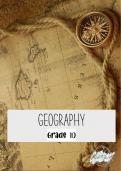Zusammenfassung
Summary Grade 10_Geography Noteset
- Kurs
- Hochschule
The Grade 10 Geography Notebook is the perfect study companion for any student who wants to excel in their geography class. With its colorful design and easy-to-understand format, this notebook will help students retain information and improve their understanding of the subject. Whether you're a vi...
[ Mehr anzeigen ]



